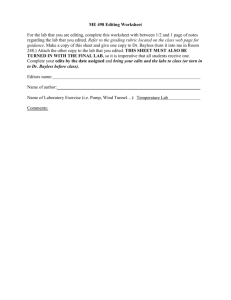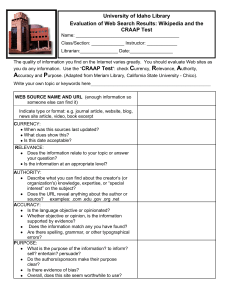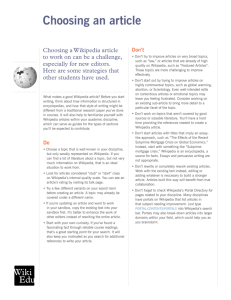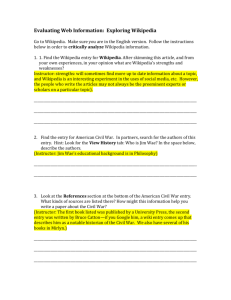Analyzing the creative editing behavior of Wikipedia editors
advertisement
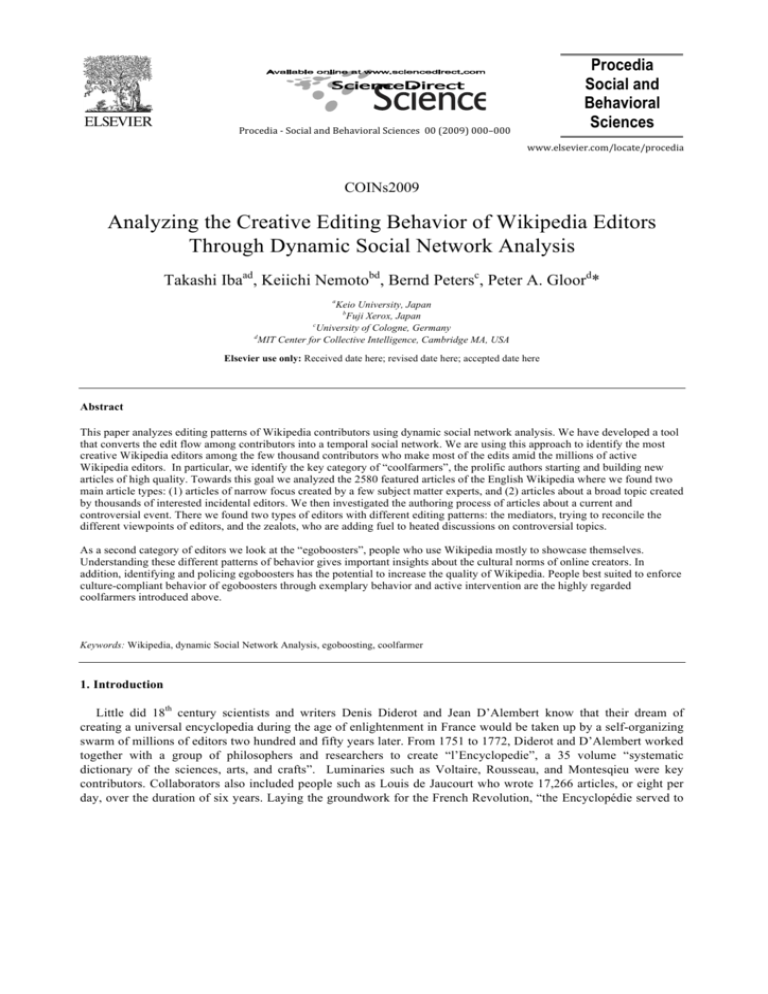
Available online at www.sciencedirect.com Procedia Social and Behavioral Sciences Procedia ‐ Social and Behavioral Sciences 00 (2009) 000–000 www.elsevier.com/locate/procedia COINs2009 Analyzing the Creative Editing Behavior of Wikipedia Editors Through Dynamic Social Network Analysis Takashi Ibaad, Keiichi Nemotobd, Bernd Petersc, Peter A. Gloord* a Keio University, Japan b Fuji Xerox, Japan c University of Cologne, Germany d MIT Center for Collective Intelligence, Cambridge MA, USA Elsevier use only: Received date here; revised date here; accepted date here Abstract This paper analyzes editing patterns of Wikipedia contributors using dynamic social network analysis. We have developed a tool that converts the edit flow among contributors into a temporal social network. We are using this approach to identify the most creative Wikipedia editors among the few thousand contributors who make most of the edits amid the millions of active Wikipedia editors. In particular, we identify the key category of “coolfarmers”, the prolific authors starting and building new articles of high quality. Towards this goal we analyzed the 2580 featured articles of the English Wikipedia where we found two main article types: (1) articles of narrow focus created by a few subject matter experts, and (2) articles about a broad topic created by thousands of interested incidental editors. We then investigated the authoring process of articles about a current and controversial event. There we found two types of editors with different editing patterns: the mediators, trying to reconcile the different viewpoints of editors, and the zealots, who are adding fuel to heated discussions on controversial topics. As a second category of editors we look at the “egoboosters”, people who use Wikipedia mostly to showcase themselves. Understanding these different patterns of behavior gives important insights about the cultural norms of online creators. In addition, identifying and policing egoboosters has the potential to increase the quality of Wikipedia. People best suited to enforce culture-compliant behavior of egoboosters through exemplary behavior and active intervention are the highly regarded coolfarmers introduced above. Keywords: Wikipedia, dynamic Social Network Analysis, egoboosting, coolfarmer 1. Introduction Little did 18th century scientists and writers Denis Diderot and Jean D’Alembert know that their dream of creating a universal encyclopedia during the age of enlightenment in France would be taken up by a self-organizing swarm of millions of editors two hundred and fifty years later. From 1751 to 1772, Diderot and D’Alembert worked together with a group of philosophers and researchers to create “l’Encyclopedie”, a 35 volume “systematic dictionary of the sciences, arts, and crafts”. Luminaries such as Voltaire, Rousseau, and Montesqieu were key contributors. Collaborators also included people such as Louis de Jaucourt who wrote 17,266 articles, or eight per day, over the duration of six years. Laying the groundwork for the French Revolution, “the Encyclopédie served to Iba, Nemoto, Peters, Gloor / Procedia – Social and Behavioral Sciences 00 (2009) 000–000 recognize and galvanize a new power base, ultimately contributing to the destruction of old values and the creation of new ones” (Donato & Maniquis 1992). Just like the radical goals of l’Encyclopedie, Wikipedia exhibits a similar potential of creating an encyclopedia of today’s knowledge unsurpassed in breadth and actuality. But other than l’Encyclopedie, the Wikipedia authors are not the leading scientists of our time, but a wide mix of millions of volunteers from all around the world. While it took the team around Diderot and D’Alembert over twenty years to write 71,818 articles, the over 75,000 active Wikipedia contributors needed just seven years to write more than 13 million articles in 260 languages. In this paper we would like to investigate the creative behavior of today’s Diderots’, D’Alemberts’, and Jaucourts’. While in principle everybody can edit Wikipedia articles, in practice there are different categories of editors. For example for the English language Wikipedia, there are (July 2009) over 10 million registered users, out of which 400,000 are considered active editors, defined as making more than 10 edits. Additionally there are over 1600 administrators who stand guard over their assigned subset of articles against vandals. In principle Wikipedians can edit their articles anonymously, in practice however, the most active Wikipedians take great pride in their editing activity, and maintain their online profile and reputation with great care. Building on extensive previous research (Nov 2007, Kittur & Karaut 2008, Brandes et. al. 2009, Viegas et. al. 2004, Priedhorsky et. al. 2007) this paper explores the behavior of people spending large amounts of time contributing to the greater good, by helping to build an encyclopedia of much greater width and depth than could ever have been done by an individual or small group of experts. 2. The Main Editing Patterns of Wikipedia As has been shown repeatedly (Priedhorsky et. al. 2007, Chi 2007), there is a very small number of contributors among the hundreds of thousands of active Wikipedia editors who make most of the edits. Figure 1 illustrates the editing pattern of registered and unregistered Wikipedia editors in the Japanese Wikipedia, patterns in the English Wikipedia are very similar (Chi 2007). The left side of figure 1 depicts a log-log rank-order graph of the users of the Japanese Wikipedia, illustrating that one user did close to one million edits, while one vast majority did one to five edits. The right side of figure 1 shows the distribution of the number of edits, comparing the unregistered users (distinguished by their IP-number) in blue (N=1,582,474) with the registered “named” users (N=146,175). Figure 1. Log‐log plot of frequency of edits against numbers of users (left graph: x‐axis: user rank, y‐axis: # of edits, right graph: x‐axis: # of edits, y‐axis: probability of the # of edits) (Japanese Wikipedia) Iba, Nemoto, Peters, Gloor/ Procedia – Social and Behavioral Sciences 00 (2009) 000–000 As figure 1 illustrates there is a tiny minority of named users making between 10,000 and 100,000 edits, and a similarly small number of anonymous users making between 5,000 and 10,000 edits, while the overwhelming majority of users (100,000 named and 1,000,000 IP users) only makes 1 to 5 edits, with 40% of all IP users making just one edit. At the same time, coordination and getting to agreement on the different articles takes up increasing amounts of time among Wikipedians. Figure 2 illustrates that while the overall growth of Wikipedia (measured in bytes) is roughly linear, bytes produced on the discussion pages, where Wikipedians sort out their disagreements over a particular article have been growing much more steeply for the last two years, and are flattening at a slower pace than the main pages. Figure 2. Growth patterns of text pages (main) and discussion pages (x‐axis: subsequent days since Wikipedia started), y‐axis: bytes added on a particular day) Motivated by these two simple insights, we would like to study the research question of how the most active editors succeeded in productively editing close to 100,000 articles over the last 6 years. Secondly, motivated by the apparently disproportional growth in discussion activity, we would like to better comprehend the coordination mechanisms among Wikipedians, to explore the resolution process of how the swarm succeeds in coming to agreement on frequently diagonally opposed starting positions, such as e.g. during the 2008 US presidential elections, when hot online wars were fought in Wikipedia on the pros and cons of Republican Vice Presidential candidate Sarah Palin1. 3. Sequential Collaboration Networks of Featured Articles To better understand positive collaboration patterns, we analyzed all 2580 featured articles of the English Wikipedia. Featured articles are considered to be the best articles in Wikipedia, voted for by Wikipedia's editors. 1 http://boingboing.net/2008/08/30/who-scrubbed-wikiped.html Iba, Nemoto, Peters, Gloor / Procedia – Social and Behavioral Sciences 00 (2009) 000–000 Figure 3. 2580 featured articles (x‐ axis: numbers of editors, y‐axis, average shortest path length of sequential collaboration network) Figure 3 illustrates the editing characteristics of the different featured articles, ranging from the article about Australia with 4000 different editors, with each doing on average less than ten edits, to the article about Damien (South Park), an article about an episode in a television series, being written mostly by a few editors with an average of sixty edits per editor. For our analysis we used the Wikipedia CollaboAnalyzer tool developed by Iba et al. (Iba & Itoh 2009) to parse the collaboration network. Figure 4 illustrates the CollaboAnalyzer parsing logic, constructing a relationship between editor A and editor B, if editor B follows on work done by editor A. Figure 4. Converting editing changes into a social network Figure 5 illustrates the featured article “Mozart in Italy.” This article follows a conventional encyclopedia authorship pattern, with very few authors (24) writing the article in few different editing steps (6). This structure fits the topic of the article, which is highly specialized. There is only a small pool of subject matter experts Iba, Nemoto, Peters, Gloor/ Procedia – Social and Behavioral Sciences 00 (2009) 000–000 knowledgeable about “Mozart in Italy”, indeed in this article one editor (BrianBoulton) does the majority of the writing. Figure 5. Editing Network of Featured Article “Mozart in Italy” Figure 6 depicts an article with very different editing characteristics. The article about Australia has almost four thousand different editors, with no clearly recognizable leader. Each of the editors does relatively few different edits. Considering the subject matter of the article, this again makes sense, as everybody who was ever in Australia can considers her/himself an expert and might have something to contribute. Figure 6. Editing Network of Featured Article “Australia” It might be expected that it makes more sense for an article with an editing network structure of type “Mozart in Italy” to be a featured article than for one of type “Australia”. It seems much easier for a small group of experts to produce a superb article, than for a huge swarm of thousands of Australia travelers. Our question therefore becomes: what communication and coordination mechanisms are these swarms of editors using to produce top-rated Iba, Nemoto, Peters, Gloor / Procedia – Social and Behavioral Sciences 00 (2009) 000–000 articles? As it turns out, even in such a large swarm, not everybody is equal. For each article there are a few outstanding editors, who succeed in coordinating the editing process to produce a featured article. We call these Wikipedians the “coolfarmers”, the authors and editors who, like Louis de Jaucourt two centuries ago at L’Encyclopedie, are the indispensable backbone of the Wikipedia community. (Priedhorsky et. al. 2007) introduced the “persistent word view” metric to measure the capability of an editor to create value. He and his colleagues looked at the total views per months that the accumulated words of an editor gathered. What they found is that the top 10% of editors by number of edits contributed 86% of the persistent word views, and the top 0.1% contributed 44% of all persistent word views. So there is a tiny fraction of editors who contribute most of the value to Wikipedia – the “Jaucourt’s” do really exist also in the virtual, self-organizing Wikipedia world. The next section looks at the editing and communiation patterns of today’s Jaucourt’s, the most prolific authors who form the backbone of Wikipedia, 4. Coolfarming Editing Patterns Wikipedians are famous for integrating latest controversial developments into their online encyclopedia. Examples of heated discussion and high-editing activity on high-profile events abound. When noted black scholar Henry Louis Gates was handcuffed in his own home by the Cambridge police on July 16, 2009, the immense discussion subsequently arising in newspapers and blogs found its reflection in the Wikipedia page of Henry Louis Gates. Figure 7 shows 6 snapshots of the Condor (Gloor& Zhao, 2004) movie depicting the edit network. The first screen shot at the upper left shows the structure on July 18, when the press and Wikipedians first became aware of the events. Initially, reporting happened on the pre-existing Wikipedia page of Henry Louis Gates. On July 24th, a separate page “Arrest of Henry Louis Gates” was created (blue network) in the top middle window in figure 7. As can be seen in the subsequent snapshots three and four (top right, lower left) a large number of editors started working on both articles in parallel (red dots), with about the same number of edits in both articles. The dense network in snapshot four illustrates the controversy leading to an ‘editing fight’ between the editors defending the professor and the editors defending the cop. Figure 7. Sequential SNA pictures of the social network of Wikipedia editors working on the Henry Louis Gates article Iba, Nemoto, Peters, Gloor/ Procedia – Social and Behavioral Sciences 00 (2009) 000–000 Snapshot five, in the middle lower row, shows that the main editing activity is now focused on the article “Arrest of Henry Louis Gates” (blue network). Snapshot six, in the lower right, illustrates that on day 11 editing activities are cooling down, with four editors doing edits on the “Henry Louis Gates” page, and a larger number of editors doing controversial editing on the “Arrest of Henry Louis Gates” article. No editor is working on both pages on day 11. Figure 8 illustrates the combined editing volume of the two pages “Henry Louis Gates” and “Arrest of Henry Louis Gates”. The number of edits (left side of figure 8) peaked on day 3, slowing down over the next eight days. Interestingly, the number of new users was highest in the beginning (right side of fig. 8). This shows that initially many editors joined, each doing a few edits. Subsequently fewer new editors joined until day nine. Figure 8. Number of edits per day on the Henry Louis Gates articles July 18 to 30 (left) and number of new editors on each day (right) (x‐ axis: time, y‐axis: number of edits (left), number of new users on each day (right)) Figure 9 illustrates changes in betweenness centrality in the network movie of figure 7. The left side of figure 9 shows group betweenneess centrality, illustrating that betweenness went down until day 7, and then sharply up on day 11. This means that a few editors, most likely one, became very central in this phase. Figure 9. At left: Betweenness and degree centrality of 12 days (x‐axis: time, y‐axis: betweenness (red) and degree centrality (blue) ), At right: Temporal Social Surface of Wikipedians editing the Henry Louis Gates Story The temporal social surface at right in figure 9 illustrates the same process, showing that the number of contributors peaked early on – the elevated layer in the first third along the y-axis – while very few contributors are substantially more central than the others. The same can also been seen in the screen snapshots in figure 7. Iba, Nemoto, Peters, Gloor / Procedia – Social and Behavioral Sciences 00 (2009) 000–000 Figure 10. Betweenness of key contributors to Henry Louis Gates articles on July 24, 2009 Figure 10 illustrates the editing network of the key contributors on July 24, 2009. The three Wikipedians arcayne, golddragon, and classicfilms are most central on that day. The three smaller inset windows show the temporal betweenness centrality of these three editors over the 12 days. Classicfilms is only highly active from days two to four, golddragon has a peak at day 4, while arcayne is actively editing during the entire period. In order to understand more about the communication and interaction behavior of the most active Wikipedians, we next looked at the discussion pages of these potential coolfarmers. Figure 11 illustrates the discussion networks of 4 active Wikipedians, each line is a response to a comment on the talk page of the Wikipedian. Three out of the four are among the 4000 most active Wikipedias by number of edits (the yellow one is less active). The red dots mostly in the center are Wikipedians who post on more than one of the talk pages of these 4 active editors. The large number of red dots illustrates again that the group of active Wikipedians is a small world structure, as the group of red actors is in the core of the talk network of these three most active editors. Iba, Nemoto, Peters, Gloor/ Procedia – Social and Behavioral Sciences 00 (2009) 000–000 Figure 11. Talk pages of 4 very active Wikipedias, two of them got into a small flame war about the “Henry Louis Gates Arrest” article Figures 12 to 14 show the individual talk networks of three of the most active editors also shown in figure 11. Note that the owners of the talk pages themselves have been removed as actors in these pictures, to look at the dialogues other users are having on the talk pages of the respective editors. We take this discussion as a proxy for the group-building – i.e. coolfarming – capabilities of these three editors. User rjwilmsi is the most active Wikipedian by number of edits of all Wikipedians. Considering this, his network is surprisingly sparse. At the left of figure 12 there is the contribution index as defined in (Gloor et. al 2003). Rjwilmsi’s dialogue with Reedy is the most active, with just 24 exchanges, very few compared to the dialogues other coolfarmers are having. This is most likely because edits made by the bots developed by rjwilmsi also count towards rjwilmsi’s edits. His dialogue with others is very short and linear, there are very few information exchanges where groups of people are involved. Graphical, in his graph there are only threads, and no clusters of people. Figure 12. Talk page of most active Wikipedian (rjwilmsi) by edits (#edits: 327,353) as listed on http://en.wikipedia.org/wiki/List_of_Wikipedians_by_number_of_edits Iba, Nemoto, Peters, Gloor / Procedia – Social and Behavioral Sciences 00 (2009) 000–000 User peregrine_fisher (figure 13) shows a different communication pattern. He triggers more extensive exchanges among other users; with the most active communication partner he is exchanging 74 posts. In addition, there are complex edit networks, where groups of people engage into a mutual interaction, shown in the small groups and cliques at the left of figure 13. Figure 13. Talk page network of respected Wikipedian (peregrine_fisher) (#edits: 19013) Figure 14 shows the talk page of user mav. User mav has the highest “persistent word view” count as defined in (Priedhorsky et. al. 2007). This means that he is the most read Wikipedian. His edit count is much lower, though, than that of rjwilmsi shown in figure 12. Figure 14. Talk page network of respected Wikipedia “mav”, having the highest persistent word view in (Priedhorsky et. al. 2007) (#edits: 74,876) Figure 15 illustrates the differences in behavior among different types of coolfarmers though their social temporal surfaces (Gloor 2005). Notice the difference in communication pattern between the top row (mav and Iba, Nemoto, Peters, Gloor/ Procedia – Social and Behavioral Sciences 00 (2009) 000–000 peregrine_fisher) and the bottom row (rjwilmsi and arcayne). All four are among the most active editors by number of edits. Rjwilmsi however has a very small number of conversations, while mav and peregrine_fisher are engaging into many small-group discussions with other editors. In particular, their fluctuation in betweeness centrality is much higher than the one of rjwilmsi and arcayne. Reading the discussion pages of these four Wikipedians, we found that the top two (mav, peregrine_fisher) are mostly conciliatory in nature, while the bottom two are quite provocative at times. Mav and peregrine_fisher have a positive conversation pattern, where they and a few others are at any given point in time engaged in a constructive dialogue. For example, on the page of Henry Louis Gates, Arcayne takes clear sides and weighs in on the topical discussion, while peregrine_fisher assumes the neutral position of an elder statesman. Arcayne also uses many adjectives such as “resolutely affirm”, “complete and utter trivia”, “end in tears and dramah”, while peregrine_fisher is much more factual. Figure 15. Temporal social surfaces of four prominent Wikipedians (x‐axis: different actors sorted by increasing betweenness at any given point in time, y‐axis: time, z‐axis: betweenness of actor) Figure 15 therefore illustrates that there are two types of coolfarmers: the mediators (top) and the zealots (bottom). E.g. user arcayne has a relatively flat temporal surface structure, which means that a few people are continuously highly central – engaged in one-to-one fights with arcayne, similarly to user rjwilmsi. In prior work, we found fluctuations in betweenness centrality to be indicative of personal creativity (Kidane & Gloor 2007). Mav and peregrine_fisher have much more of this diversified dialogue with other Wikipedians as indicated by the change in betweenness centrality their talk page. After this analysis of the most creative, coolfarming Wikipedians, the next section looks at the more negative category of Wikipedians who mostly participate to boost their own ego. 5. Two opposite roles in Wikipedia: Egoboosters against Coolfarmers According to Bromley (1993) reputation can be separated from the person it belongs to. This leads to the effect that “[…] people take action to enhance and protect their reputation, because it has value for them […]” (Bromley, 1993, p.59). In earlier research investigating the motivation of Wikipedians, Nov (2007) found that the top reasons Iba, Nemoto, Peters, Gloor / Procedia – Social and Behavioral Sciences 00 (2009) 000–000 for Wikipedians to collaborate were fun and ideology, while social aspects such as being with friends, positive influence on one’s career and social responsibility were less prominent. While this is true for the majority of Wikipedians, there is a significant fraction of Wikipedia editors who are spending most of their time polishing their own profile – we call them the egoboosters. Wikipedia offers an easy way to influence one’s reputation by doctoring one’s own article. For these egoboosters, while they maintain and contribute to other articles, their main reason for participating is furthering their own agenda by editing their own article. One of these egoboosting Wikipedia editors was user “essjay”, who became infamous for claiming to be a tenured professor of religion, while in reality he was a 24 year old college student dropping out of community college. What was true was that he spent up to 14 hours per day editing Wikipedia pages, until his fake identity was discovered, and he had to give up his Wikipedia administrator position. It also seems that essjay spent a disproportionate amount of his online Wikipedia time editing his user page2. Essjay is symptomatic for people of the egobooster category, who invest their time to polish their own ego and increase peer recognition. Egoboosters range from distinguished academics spending disproportionate amounts of time and Web space to edit their otherwise legitimate articles to people with no visible claim to fame who succeed in sneaking their profile page by other Wikipedia vigilantes. While essjay got to (negative) prominence, we suspect that there is a huge number of hidden egoboosters. Out of the slightly less than 400,000 people pages in the category “living people”, close to 80,000 have fewer than three back links, i.e. are candidates for egobooster pages. Figure 10 displays three types of egoboosters we found, the snake, wheel, and star. Figure 16. Three types of egobooster networks: snake, wheel, and star. The snake-network at left in figure 16 was likely created by the person profiled (at the bottom on the left side), but then was further edited by other users, leading to the thread structure. The star-network at the right in figure 16, a hub and spoke structure, is dominated by the person in the center, who is also the person being profiled. The hub and spoke structure arises from the person in the center consistently and immediately correcting changes done by the other editors. The wheel-network in the center was created by one person in the circle, who is also the person being profiled, then edited by others, and then again by the person being profiled. The comment page of the Wikipedia page whose edit network is depicted in the center of figure 16 even had the comment “What a self-portrayal of a ‘Media Scientist’ without a teaching chair or even a teaching assignment. Is this permitted? I think it should be deleted”. While the editor responsible for the snake structure has no visible further control over the development of the article, the editor responsible for the hub and spoke star-network at the right in figure 16 is the most radical egobooster, relentlessly checking and immediately resetting and correcting any changes which she/he does not like. 2 Martin Wattenberg, personal communication at a talk at the MIT Center for Collective Intelligence Iba, Nemoto, Peters, Gloor/ Procedia – Social and Behavioral Sciences 00 (2009) 000–000 The intent of this user is to have full control over the article. The users responsible for a wheel-network try to influence the article. The intent of the user in the snake-structure is to create the article and then let others do the further edits. Of course it could also be that the further IP users in the thread type networks are the original “snake” editing his/her article under different pseudonyms. On the discussion pages of some egobooster articles the suspicion is brought up that friends, colleagues or students are helping the respective egoboosters to maintain their article. This reputation management strategy is known as self-presentation by proxy (Bromley 1993), where one person encourages others in her social network to extend or improve her reputation. With this strategy it is possible to perform reputation management without triggering the suspicion to be manipulative. Unfortunately, information about “real world” relationships among the editors of an article is not easily available, but obviously the potential that others are involved in egoboosting is smaller when analyzing a star structure compared to a snake structure because the editor in the center of the star network controls the edit-flow while responding to edits from others. Table 1 summarizes the characteristics of the three types of egoboosting networks. Snake Wheel Star Degree of control small medium high Goal of egobooster create article influence article control article Table 1. Characteristics of egoboosting networks Figure 17. Star‐like Egobooster network of a prominent scientist Figure 17 displays a much more complex egobooster network. The massive black dot in figure 17 is the scientist himself, immediately correcting edits he does not like, leading to a hub and spoke network. But as he – besides Iba, Nemoto, Peters, Gloor / Procedia – Social and Behavioral Sciences 00 (2009) 000–000 being an egobooster – is also a reputable and recognized scientist, his network also has a long tail at left in figure 17, where other editors have been making changes to his page, without egobooster intervention. Figure 18. Egobooster star‐network of a not so prominent scientist Figure 18 illustrates the same structure for a less prominent academic who also seems to doctor his own profile. He is revising and undoing some edits in the hub-and-spoke network in the box at right, while further changes are made by others in subsequent edits in the mostly linear thread at left. While most egoboosters make up a username for editing, there are also examples where the users edit anonymously with an IP-address. This makes it harder to track who might be the egobooster. Figure 19 shows a three-star example where the egobooster probably edits with at least two different IP-addresses (the two red nodes). Figure 19. Anonymous egobooster with two IP‐addresses (red) Iba, Nemoto, Peters, Gloor/ Procedia – Social and Behavioral Sciences 00 (2009) 000–000 In other instances the egoboosters take no measures to hide their identity, choosing their real name as username to create an article about themselves. In the cases where we encountered this behavior, the networks were of the single-threaded “snake” type, which means that either the egobooster started the article, and then let others do subsequent editing, or continued editing using pseudonyms or changing IP addresses for all further edits. 6. Conclusions While coolfarmers are the backbone of Wikipedia, recognizing and adequately responding to egoboosters poses major ethical challenges. Leaving egoboosters unpunished degrades the quality of Wikipedia, thus also doing a huge disservice to the tireless and immensely valuable work of the coolfarmers. We therefore think that identifying the patterns of coolfarmers and egoboosters will bring a big benefit to Wikipedia. Debunking the egoboosters takes a lot of moral authority, and who better to apply that moral authority by removing and/or reprimanding egoboosters than the coolfarmers. Finding suitable and hard-to-spam metrics for identifying the most valuable contributors to Wikipedia has direct practical applicability beyond finding the egobooster, by e.g. proposing alternate ranking systems for the quality of articles based on the quality of contributors. In this paper we have looked at the English and Japanese Wikipedia, while neglecting any structural differences there might be in the different-language versions. In the future, we anticipate that we even might be able to discover differences in the online behavior of different national cultures. As a motivation, consider the following observation: Wikipedia exists in many languages; the English language Wikipedia alone boasts 2,772,824 articles (as of March 4, 2009) and 9,107,139 registered users. The Wikipedia in Finnish at the same time had 195 849 articles and 105 904 registered users. The Korean Wikipedia, on the other hand, had 91,215 articles and 61,379 registered users. This is quite amazing, because both countries are among the heaviest users of the Internet and both speak a language that is unique and not shared by any other country. On the other hand, South Korea has 49 million inhabitants, while Finland has 5 million. That means that Finland, a country with ten percent the population of Korea, maintains a Wikipedia with twice the number of articles as Korea. Why is it that two countries with comparable levels of technical sophistication and wealth show such vast differences in Wikipedia creation and usage? We think that we might be able to discover some answers to this puzzle by comparing the knowledge acquisition and dissemination behavior between “Western” and “Eastern” cultures. We have already analyzed knowledge sharing behavior in answering Web sites such as Naver in South Korea and Yahoo!answers in the US (Kang & Gloor 2009). In future work we hope to identify different “coolfarming” behavior among the different language versions of Wikipedia, hopefully leading to new insights on the online culture of different societies. References Brandes, U., Kenis, P., Lerner, J., & van Raaij, D. (2009). Network Analysis of Col-laboration Structure in Wikipedia. In Proceedings of the 18th international conference on World wide web - WWW '09 (p. 731). New York: ACM Press. Bromley, D. B. (1993). Reputation, Image and Impression Management. Chichester, England: John Wiley & Sons, Ltd. Casciaro, T. (1998). Seeing things clearly: social structure, personality, and accuracy in social network perception. Social Networks, 20(4), 331351. Casciaro, T., Carley, K. M., & Krackhardt, D. (1999). Positive Affectivity and Accuracy in Social Network Perception. Motivation and Emotion, 23(4), 285-306. Chi, E.H. Kittur, N. Pendleton, B. Suh, B. (2007) Long Tail of user participation in Wikipedia. http://asc-parc.blogspot.com/2007/05/long-tailand-power-law-graphs-of-user.html Donato, Clorinda, Maniquis, Robert M. (1992) The Encylopédie and the Age of Revolution. Ed. Boston: G. K. Hall. Gloor, P. (2005) Capturing Team Dynamics Through Temporal Social Surfaces, Proceedings of 9th International Conference on Information Visualisation IV05, London, 6-8 July 2005. Gloor, P. A. Zhao, Y. (2004). TeCFlow – A Temporal Communication Flow Visualizer for Social Network Analysis. In ACM CSCW Workshop on Social Networks. Chicago: ACM CSCW Conference. Gloor, P. Laubacher, R. Dynes, S. Zhao, Y. (2003) Visualization of Communication Patterns in Collaborative Innovation Networks: Analysis of some W3C working groups. ACM CKIM International Conference on Information and Knowledge Management, New Orleans, Nov 3-8, 2003. Hall, A. (2004). Leader reputation and accountability in organizations: Implications for dysfunctional leader behavior. The Leadership Quarterly, 15(4), 515-536. Iba, Nemoto, Peters, Gloor / Procedia – Social and Behavioral Sciences 00 (2009) 000–000 Hanneman, R. A., & Riddle, M. (2005). Introduction to Social Network Methods. Riverside, CA: University of California. Iba, T. & Itoh, S. (2009). Sequential Collaboration Network of Open Collaboration, In International Workshop and Conference on Network Science. Itoh, S., Yamazaki, Y., & Iba, T. (2009). Analyzing How Editors Write Articles In Wikipedia. In Applications of Physics in Financial Analysis (APFA7). Kang, M., & Gloor, P. (2009). Comparing Online Behaviour in Korea and the US - Yahoo! Answers versus Naver Knowledge-in. Kidane, Y. Gloor, P. (2007) Correlating temporal communication patterns of the Eclipse open source community with performance and creativity, Computational & Mathematical Organization Theory. Volume 13, Issue 1 (March 2007), ISSN:1381-298X, 17 - 27, 2007 Kittur, A., & Kraut, R. E. (2008). Harnessing the Wisdom of Crowds in Wikipedia: Quality Through Coordination. In Proceedings of the ACM 2008 conference on Com-puter supported cooperative work - CSCW '08 (p. 37). New York: ACM Press. Kittur, A., Chi, E. H., & Suh, B. (2009). What's in Wikipedia? Mapping Topics and Conflict Using Socially Annotated Category Structure. In Proceedings of the 27th in-ternational conference on Human factors in computing systems - CHI '09 (p. 1509). New York: ACM Press. Kittur, A., Suh, B., Pendleton, B. A., & Chi, E. H. (2007). He Says, She Says: Conflict and Coordination in Wikipedia. In Proceedings of the 25th international conference on Human factors in computing systems - CHI '07 (p. 453). New York: ACM Press. Kudaravalli, S., & Faraj, S. (2008). The Structure of Collaboration in Electronic Networks. Journal of the Association for Information Systems, 9(10/11), 706-726. Nov, O. (2007). What Motivates Wikipedians? Communications of the ACM, 50(11), 60-64. Pittenger, D. J. (1993). The Utility of the Myers-Briggs Type Indicator. Review of Educational Research, 63(4), 467-488. Priedhorsky, R. Chen, J. K. Lam, S. K. Panciera, K. Terveen, L. Riedl, J. (2007) Creating, Destroying, and Restoring Value in Wikipedia. GROUP’07, November 4–7, 2007, Sanibel Island, Florida, USA. Suh, B., Chi, E. H., Kittur, A., & Pendleton, B. A. (2008). Lifting the Veil: Improving Accountability and Social Transparency in Wikipedia with WikiDashboard. In Proceed-ings of the 26th international conference on Human factors in computing systems - CHI '08 (p. 1037). New York: ACM Press. Suh, B., Chi, E. H., Pendleton, B. A., & Kittur, A. (2007). Us vs. Them: Understanding Social Dynamics in Wikipedia with Revert Graph Visualizations. In 2007 IEEE Symposium on Visual Analytics Science and Technology (pp. 163-170). Sacramento: IEEE. Viégas, F. B., Wattenberg, M., & Dave, K. (2004). Studying Cooperation and Conflict between Authors with history flow Visualizations. In Proceedings of the 22nd interna-tional conference on Human factors in computing systems - CHI '04 (Vol. 6, pp. 575-582). New York: ACM Press. Viegas, F. B. Wattenberg, M. Kriss, J. van Ham, F. (2007) Talk Before You Type: Coordination in Wikipedia. Hawaii International Conference on System Sciences, IEEE, Wikipedia entry on Encyclopédie, http://en.wikipedia.org/wiki/Encyclopédie
